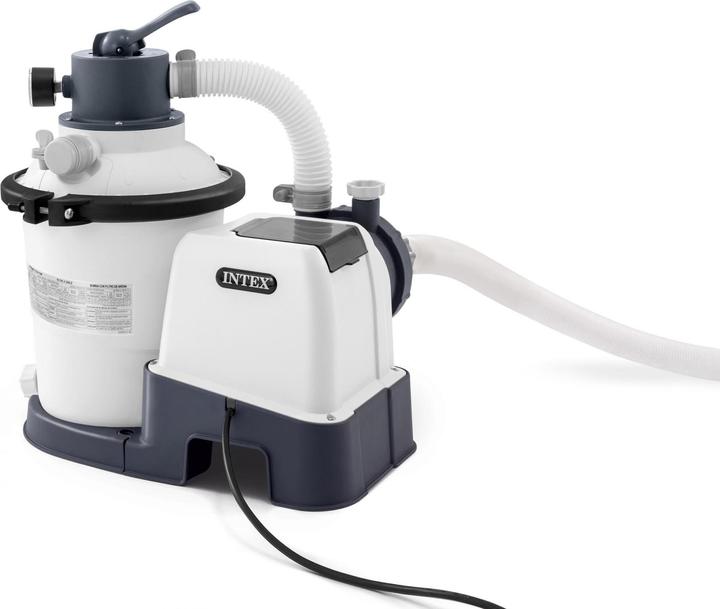

Kicking out the cartridge: this sand filter pump now cleans our pool water
Our above-ground pool came with a filter pump and cartridge. It was okay, but I’ve since switched to an alternative. The Intex SX925 keeps the water much cleaner.
I used to have to change our pool’s small filter pump at least every two weeks. I didn’t even need a reminder in my calendar. As soon as the water stopped bubbling at the inlet nozzle, it was obvious the filter had accumulated too much dirt.
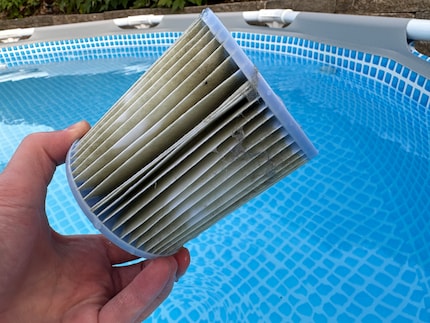
It’s quite impressive how much slimy stuff accumulates within just a few days. Of course, you could rinse it out. It might work once or twice with water, a small brush and a bit of patience. Nevertheless, I used more than a few new filters last summer, which is quite expensive and creates waste.
I needed a better solution: one that’d reduce operating costs and effort and ensure consistently clean water. The logical option was a sand filter pump. I chose a small one from Intex.

Our round pool – just over three metres in diameter – is one of the smaller ones around. It holds approximately 4,500 litres of water, which – in theory – the SX925 needs less than an hour and a half to completely filter. By comparison, our small cartridge pump would need to run for at least three times as long.
Pool manufacturers recommend circulating the water in the pool – i.e. running it through the pump – at least twice a day. So, you need to know the volume of your pool to choose the right filter pump. An 11-year-old’s geometry skills, Google or ChatGPT can help with this.
Installation and assembly
The SX925 is essentially made up of two parts: the sand filter and the pump motor. I follow the instructions, filling the container with sand I purchased separately – it’s not included. You have to pay attention and get the right grain size and degree of irregularity. I chose this beautiful green shimmering sand.
If you don’t want to use sand, there are also filter balls. I’ll try them out over the course of the season. The balls are supposed to filter well even at lower pump pressures, increasing the lifespan of the pump and reducing its power consumption.
I pour about half of the sand from the bag into the Intex container. There’s a bar in the middle with a minimum/maximum indicator, so I know when there’s enough sand.
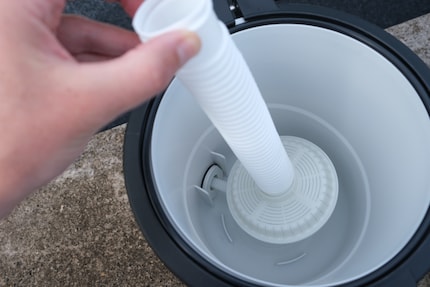
Then it’s just a matter of adding the sealing ring, putting the lid on and securing it with a clamping ring. It’s generally worth consulting the manual. The lid should be positioned so that a short connecting hose to the pump can be attached later. If the opening for this is on the wrong side of the container, you’ll have to undo the lid again.
Next, I take on the pump motor. Its four inlets and outlets and selector lever on the four-way valve are pretty intimidating to start with. I’ll worry about the operating modes later. First, I install the hoses for the inlet and outlet to the pool. This is no different than with the small cartridge filter and works perfectly. The small hose clamps may be made of cheap plastic, but they still provide good hold. Then I connect the aforementioned connecting hose from the pump motor to the filter bucket – and that’s the setup done.
Use
Now I can turn on the pump. But only after I’ve filled it with water, meaning the water’s flowed through the hose and into the device by gravity. If you run the SX925 dry, it’ll overheat and break in no time.
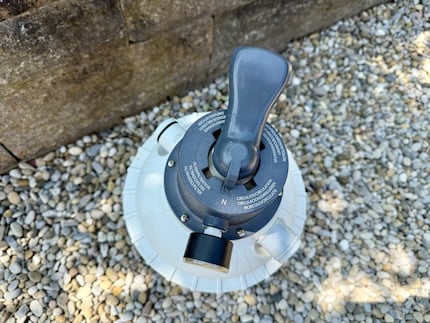
The four-way valve has four possible settings. I mainly use two in everyday life.
- Filtering: water’s sucked out of the pool, pushed through the filter sand and then pumped back into the pool.
- Backwashing: I use this every few days to reverse the water flow. However, the dirt from the filter sand doesn’t flow into the pool – that’d be pretty counterproductive. The dirty water drains out of a separate opening where you connect a hose. Depending on the degree of dirt, between 50 and 100 litres of dirty water will flow out. You’ll know when it’s enough because the draining water will be noticeably clear.
I use the other two modes less frequently, but they’re certainly useful:
- Circulation: water flows through the system without passing through the filter sand. This is useful if the water’s very clean and you just want to circulate it with less power consumption.
- Draining: useful if you want to empty the pool at the end of the season. The SX925 pumps the water out quite quickly, to the level of the pool drain.
It’s important that you only change the mode when the pump’s not running – i.e. when it’s switched off. Making changes while the pump’s running can cause damage not covered by the warranty.
For daily filtering, you can give the Intex SX925 something like a repeat command. You only need to set the runtime once, then the pump will start running immediately. 24 hours later, it’ll do it again, then day after day. So, you should consider when you set the automatic filtering so the pump runs at a convenient time for you. For example, I let it run in the evening after we’ve finished using the pool so the noise doesn’t bother anyone.
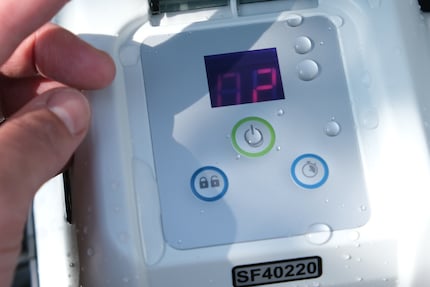
In addition to the 24-hour rhythm, you can run extra programs if necessary and activate the pump manually.
You can’t use the system with a timer. If, for example, you want to filter the water twice a day – morning and evening – you’ll have to activate it manually. Timers aren’t compatible with the SX925 switching to standby mode after it’s finished. There might be some way to do it, though – I haven’t figured it out yet.
Power consumption and costs
The manual includes a table of how long the SX925 should run daily, depending on the size of the pool. In my case, it’s three hours. In my experience, that’s actually quite enough. However, it strongly depends on how dirty the water is. After a pool party with several children, I’ve (had to) run the pump for longer.
However, with a power output of 90 watts, the consumption’s manageable. Overall, I expect a maximum of 30 kWh for the entire summer – assuming 100 days at 270 watts per day. That’s in the ten francs range, depending on local electricity prices.
The filter sand’s a bigger issue. It only lasts one season. In theory, you could probably use it for two or three years, but that’s too disgusting and a health risk as far as I’m concerned. At the end of the season, it doesn’t look very appealing anymore, so I start each season with a fresh batch. The cost: around 20 francs.
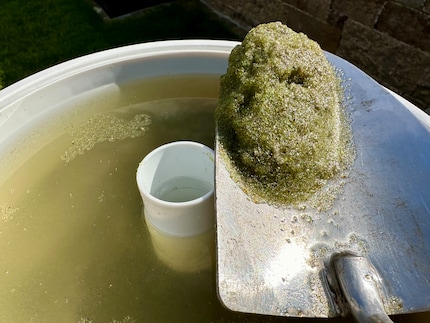
In a nutshell
Better than cartridges? Definitely!
Pro
- Simple and reliable automatic mode
- Relatively low electricity costs
- Keeps pool water cleaner than a cartridge filter
- Less material (cartridge) consumption
Contra
- Regular backwashing increases water consumption
- Filter sand only lasts one season
- The pump can only be switched on automatically once every 24 hours
Journalist since 1997. Stopovers in Franconia (or the Franken region), Lake Constance, Obwalden, Nidwalden and Zurich. Father since 2014. Expert in editorial organisation and motivation. Focus on sustainability, home office tools, beautiful things for the home, creative toys and sports equipment.
These articles might also interest you

Product test
No fuss needed: Bestway’s cordless underwater vacuum makes cleaning easy
by Martin Jungfer

Guide
Sheets, nets, chemicals – watery fun in the garden is keeping this amateur pool boy on his toes
by Martin Jungfer

Background information
Saltwater swimming pool – our own little Baltic Sea in the garden
by Patrick Vogt
